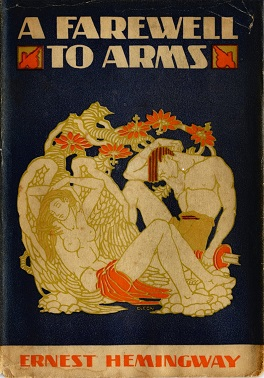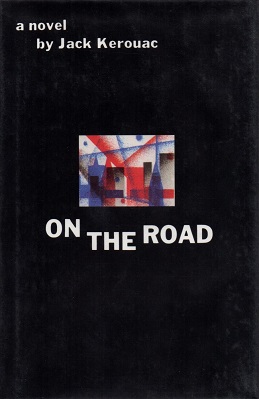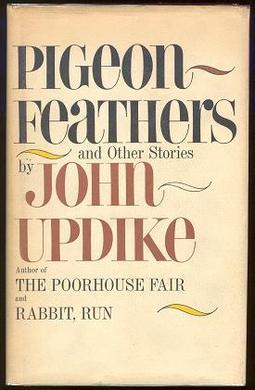
John Hoyer Updike was an American novelist, poet, short-story writer, art critic, and literary critic. One of only four writers to win the Pulitzer Prize for Fiction more than once, Updike published more than twenty novels, more than a dozen short-story collections, as well as poetry, art and literary criticism and children's books during his career.

A Farewell to Arms is a novel by American writer Ernest Hemingway, set during the Italian campaign of World War I. First published in 1929, it is a first-person account of an American, Frederic Henry, serving as a lieutenant in the ambulance corps of the Italian Army. The novel describes a love affair between the expatriate from America and an English nurse, Catherine Barkley.

On the Road is a 1957 novel by American writer Jack Kerouac, based on the travels of Kerouac and his friends across the United States. It is considered a defining work of the postwar Beat and Counterculture generations, with its protagonists living life against a backdrop of jazz, poetry, and drug use. The novel is a roman à clef, with many key figures of the Beat movement, such as William S. Burroughs, Allen Ginsberg, and Neal Cassady represented by characters in the book, including Kerouac himself as the narrator Sal Paradise.

Visions of Cody is an experimental novel by Jack Kerouac. It was written in 1951–1952, and though not published in its entirety until 1972, it had by then achieved an underground reputation. Since its first printing, Visions of Cody has been published with an introduction by Beat poet Allen Ginsberg titled "The Visions of the Great Rememberer."

Pierre Ryckmans, better known by his pen name Simon Leys, was a Belgian-Australian writer, essayist and literary critic, translator, art historian, sinologist, and university professor, who lived in Australia from 1970. His work particularly focused on the politics and traditional culture of China, calligraphy, French and English literature, the commercialization of universities, and nautical fiction. Through the publication of his trilogy Les Habits neufs du président Mao (1971), Ombres chinoises (1974) and Images brisées (1976), he was one of the first intellectuals to denounce the Cultural Revolution in China and the idolizing of Mao in the West.

Rabbit Is Rich is a 1981 novel by John Updike. It is the third novel of the tetralogy that begins with Rabbit, Run, continues with Rabbit Redux, and concludes with Rabbit at Rest. There is also a related novella, Rabbit Remembered (2001). Rabbit Is Rich was awarded the Pulitzer Prize for Fiction and the National Book Award for Fiction in 1982, as well as the National Book Critics Circle Award for Fiction in 1981. The first-edition hardcover "rainbow" dust jacket for the novel was designed by the author and is significantly different from the horizontal-stripe designs deployed on the other three Rabbit novel covers. Subsequent printings, however, including trade paperbacks, feature the stripe motif with stock images of a set of car keys or an image of a late-1970s Japanese automobile.

La Chinoise, ou plutôt à la Chinoise: un film en train de se faire, commonly referred to simply as La Chinoise, is a 1967 French political docufiction film directed by Jean-Luc Godard about a group of young Maoist activists in Paris.

Frederic Tuten is an American novelist, short story writer and essayist. He has written five novels – The Adventures of Mao on the Long March (1971), Tallien: A Brief Romance (1988), Tintin in the New World: A Romance (1993), Van Gogh's Bad Café (1997) and The Green Hour (2002) – as well as one book of inter-related short stories, Self-Portraits: Fictions (2010), and essays, many of the latter being about contemporary art. His memoir My Young Life (2019) was published by Simon & Schuster. Tuten received a Guggenheim Fellowship for Fiction and was given the Award for Distinguished Writing from the American Academy of Arts and Letters. He was awarded three Pushcart Prizes and one O. Henry Prize.

To Far to Go: the Maples Stories is a collection of 12 works of short fiction by John Updike. The stories first appeared in The New Yorker and were included in the volume published by Fawcett Publications in 1979

Pigeon Feathers and Other Stories is a collection of 19 works of short fiction by John Updike. The volume is Updike's first collection of short stories, published by Alfred A. Knopf in 1962. It includes the stories "Wife-Wooing" and "A&P ", which have both been anthologized.
"Stalking the Billion-Footed Beast" is an essay by Tom Wolfe that appeared in the November 1989 issue of Harper's Magazine criticizing the American literary establishment for retreating from realism.

The Same Door is a collection of 16 works of short fiction by John Updike published in 1959 by Alfred A. Knopf. The stories in the volume first appeared separately in The New Yorker, some in a slightly different form than in the collection. The Same Door is Updike’s first volume of short stories.

Olinger Stories: A Selection is a collection of 11 works of short fiction by John Updike published by Vintage Books in 1964.
“Pigeon Feathers” is a work of short fiction by John Updike which first appeared in The New Yorker on April 27, 1956. The story was collected in Pigeon Feathers and Other Stories (1962) by Alfred A. Knopf.

Problems and Other Stories is a collection of 23 works of short fiction by John Updike. The volume was published in 1979 by Alfred A. Knopf. The stories were first carried in literary journals, 17 of which appeared in The New Yorker. Problems and Other Stories is one of two collections of Updike's short stories that appeared in 1979.
"The Happiest I've Been" is a work of short fiction by John Updike, first appearing in The New Yorker on January 3, 1959. The story was collected in The Same Door (1959) published by Alfred A. Knopf.
“Giving Blood” is a work of short fiction by John Updike first appearing in The New Yorker on March 29, 1963. The story was collected in Too Far to Go: The Maples Stories (1979), published by Fawcett Publications.
“Wife-Wooing” is a work of short fiction by John Updike which first appeared in The New Yorker on March 12, 1960. The story was collected in Too Far to Go: The Maples Stories (1979), published by Fawcett Publications.
“Ace in the Hole" is a work of short fiction by John Updike that first appeared in The New Yorker on April 9, 1955. The story was collected in the volume of Updike's fiction The Same Door (1959), published by Alfred A. Knopf.













